

The chaotic scene of a construction site can have multiple people responsible for different jobs, working for different companies, all with their own interests. And in the middle of everything, your injured client. It’s up to you to navigate through the potential parties, identify the key issues, and gather the ammunition needed for trial. And just like any case, it begins in discovery. An effective discovery strategy in construction cases can prepare your case for trial by identifying the players, defining your theory of liability, and focusing-in on the main issues.

We have all been there: picking up the phone to introduce yourself to the adjuster or defense attorney on a new premises-liability case, and before you can even say “hello” the first words you hear are “open and obvious” or “trivial defect.” Fortunately for plaintiffs’ attorneys, these defenses aren’t all they are cracked up to be and are nowhere as damaging to plaintiffs’ cases as the defense attorneys would have you believe.